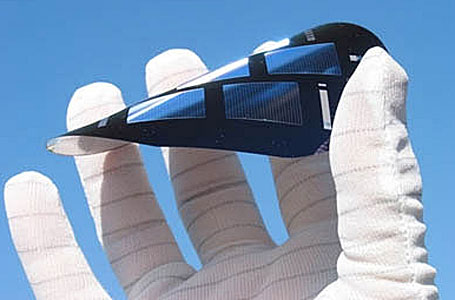
Thin film solar cells also known as thin-film photovoltaic cells are solar cells that are made up of one or more layer of photovoltaic material such as silicone, graphene or another substrate.
These types of solar cells are not really a new idea. They have been around since the inception of solar calculators. Of course these thin little strips that were used to power hand held calculators are more sophisticated now and much larger.
Thin film solar is being used today in building installations and to charge the new electric vehicles. This market has really blossomed since the early 2000’s with growth up by about 50-percent. It is predicted that thin solar cells will surpass other types of solar technology within a few years.
Application and Use
The thin nanometer to micrometer widths makes this an ideal medium to use in building construction. Sheets of this material are either laid directly on the roof or are integrated with the roof. The application of this type of solar film means no additional weight on the building from heavy solar panels.
Many consumers had to have large solar panels installed on their roofs or in spaces near their homes. This is not only an eye sore but the weight of the panels can cause undue stress on the roof. There may be other options, however, where advanced PV projects can offer more streamlined panel installations along with thin solar solutions.
Efficiency
Initially this thin solar material could only turn out about 12 megawatts. After research and development, thin film solar now offers about 40-50 megawatts and that is expected to grow and production costs drop.
Thin film is a very efficient type of material that can be used in many different applications to generate solar energy. Car manufacturers have found this material to be the material of choice to use in their electric and hybrid cars.
The efficiency is still not that of conventional panels but the prediction is that it will continue to improve because there is a definite market for the material. This is by far a much easier material to work with and to install and it is far less intrusive than traditional panels.
The Costs
Through advances in the industry the production costs have been greatly reduced which in turn has driven down the end cost. China has affected this market by mining large amounts of silicon which they have been using to produce very low cost (in comparison to previous years) conventional panels at cut rate prices.
The cost has fallen dramatically and with continued research and development into production strategies it is likely that this film will continue to decrease in price while it will increase in efficiency.
Thin film solar cells may be the answer to providing solar energy to homes and businesses that are located in urban areas where placing conventional panels is not possible. It is the goal of the industry to surpass the efficiency of conventional panels by 2014 – 2015.
More on Thin Film Solar
http://www.bloomberg.com/news/2013-10-04/thin-film-solar-tops-india-panel-performance-bnef-says.html